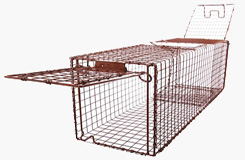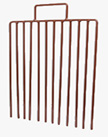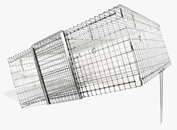


TNR And Feral Cats
What Is A Feral Cat?
Generally, a feral cat is an untamed, wild cat that was born outdoors, lives outdoors, and has experienced very little, if any, human contact. Feral cats form colonies and make their homes wherever they can find food, continuing to avoid human contact whenever possible.
In contrast, a stray cat is a domesticated outdoor cat who was probably a companion house cat, or a kitten of a companion house cat, that was abandoned or became lost. Stray cats are often friendly and affectionate; but, you should always use caution when approaching and handling a stray cat. Please see Help, I Need To Bring A Stray Cat In for more information on bringing a friendly, stray cat into your home.
While stray cats are homeless, socialized cats, often looking for human companionship, feral cats are not. Feral cats already have a home - outdoors. Most feral cats can't be socialized and are content living outdoors. Sometimes, feral kittens may be able to be tamed and adopted into homes if they are socialized when they are very young.
Additional information about feral cats can be found here:
Back to Top of TNR and Feral Cats
What Is Trap-Neuter-Return (TNR)?
Trap-Neuter-Return, or TNR, is a program in which free-roaming cats (stray and feral cats) already living outdoors are humanely trapped, evaluated, vaccinated, and sterilized. After recovering from surgery, kittens and tame (stray) cats are adopted into good homes, and healthy adult cats that are too wild to be adopted (feral) are returned to their outdoor homes.
These cats are free to live out their lives as they did before; but now, no new kittens are born and nuisance behaviors such as spraying and yowling are reduced. When homes cannot be found for the friendly, stray cats, they may be returned to their outdoor homes. There, they can continue to be cared for, along with the feral cats, by their colony caregivers who provide them with food, shelter, and love. Please see What's Next for more information on providing care and outdoor shelters for feral cats.
If the sterilized cats are not returned to the area where they were trapped, new unsterilized cats will move in and make more kittens, known as the vacuum effect. But, with TNR, the sterilized cats are returned, preventing large numbers of unsterilized cats from moving in. The breeding stops and feral cat populations are gradually reduced naturally over time.
Additional information about TNR and why it works can be found here:
Back to Top of TNR and Feral Cats
What Do I Do Before I Trap?
In addition to knowing how to safely and successfully trap free-roaming cats, you must understand the other components of TNR that take place before you begin trapping. It's essential that you set up spay/neuter appointments and prepare an area to house the cats PRIOR to trapping.
Schedule Spay/Neuter Appointments BEFORE You Trap
Always have appointments scheduled with a spay/neuter clinic or veterinarian before you begin trapping. You must be sure you'll have a place to take the cats to be fixed before trapping them.
Prepare A Pre-Surgery/Post-Surgery Recovery Room
Cats typically need to be housed in a pre-surgery/post-surgery recovery room for a total of 4 to 7 days. This room should be enclosed, so they're not exposed to other animals that could attack them while in their traps, and it should be quiet, clean, warm, safe, and dry as they'll be recovering from surgery.
Feral cats should be kept in their traps in this room. If their traps are too small for them to recover in, AFTER they have been fixed, you can carefully and safely transfer them to a larger enclosure such as a dog crate or cage. Your pets should never be in this recovery room with the feral cats. If you're trapping multiple feral cats, they can all recover in the same room in their traps, but make sure you keep the traps covered to minimize stress levels.
We recommend setting up a thick tarp to protect the floor and placing piles of shredded paper on top of the tarp. Put the trap on the shredded paper and the cat will use it as a "litter box", pulling it up through the bottom of the trap. When the paper is soiled, move the trap to a new pile of shredded paper and dispose of the dirty pile. This helps minimize the need to open the trap door.
 |
Back to Top of TNR and Feral Cats
How Do I Trap Feral Cats?
Remember, NEVER Leave A Trap Unattended!
While you might need to stay out of sight for a cat to enter a trap, you should always be close enough to see or hear when the trap is triggered. An animal left outside in a closed trap is vulnerable to attack by other animals with no way to escape. So, as soon as you have trapped the cat, the trap with the cat should be brought inside into the pre-surgery/post-surgery recovery room that you've already prepared.
Always Keep Traps Covered
You can use an old sheet to cover the trap. All sides except for the door opening should be covered while the trap is set up to catch the cat as well as after the cat is in the trap. This helps keep the trapped cat calm. Keep the cover on the trap while transporting the cat to the clinic and while the cat's recovering.
Getting The Cat Into The Trap
Bait the trap with food that is very appealing to cats and has a strong odor. Fish-flavored canned cat food, tuna fish, Kentucky Fried Chicken, sardines, etc. make excellent bait. Place the food at the back of the trap and make sure all sides of the trap surrounding the food except for the door opening are covered so that the cat can't get to the food through the sides or back of the trap.
Try to trap the cat during the time of day that you would normally feed the cat. The hungrier the cat is, the more likely the cat is to get into the trap. Some cats will get into the trap without withholding food prior to trapping. If you set the trap, but the cat doesn't go in to eat the food that's in the trap, do NOT give up and do NOT give the cat food outside of the trap. Sometimes, the best way to get a cat into a trap is to withhold food for a day. Try again later that day or the next day, but don't withhold food for longer than this. If you start trying to trap on Friday and the cat doesn't get in or eat by Sunday morning, feed the cat like normal, reschedule your appointment, and try another method.
Once the cat is in the trap, make sure to provide food and water (unless it's after midnight on the night before surgery or the morning of surgery).
If the cat is already used to eating in a large enclosable area such as a porch, garage, etc., set the trap in this area. Make the opening to this area as small as possible so it can be easily and safely closed or blocked off once the cat enters this area, allowing you to trap the cat in the large space, making it more likely that you'll be able to get the cat into the regular trap. Make sure the only food source available is in the trap so that when the cat gets hungry, the cat will get into the trap. Make sure to block off any small spaces where the cat could get stuck and to remove any objects which could be harmful to the cat.
If you have a little more time before your appointment, another method is to get the cat used to the trap before actually trapping the cat. Prop the trap door open so that it can NOT close with the cat inside (Zip Ties work well for this). Cover the trap so that the door opening is the only uncovered side. Start off by putting canned food at the opening of the trap so that the cat doesn't have to go inside the trap to eat. Over the next week or two, move the food a little further back into the trap each day until it is all the way back and the cat is used to eating inside of the trap. As long as the trap is propped open and you're sure it can't close on the cat, you can leave the trap unattended. When it's time to trap the cat for your spay/neuter appointment, unprop the door so that the next time the cat enters the trap, the door will close. Do NOT leave the trap unattended once the door can close and trap the cat.
NEVER Try To Pick Up Or Handle A Stray or Feral Cat
Even if you've been able to touch or pet the free-roaming cat in the past, do NOT try to get the cat into a carrier, trap, or other enclosure by picking up the cat. Always use traps to catch feral cats! This is the safest method for you and for the cat.
Petting a cat and picking up a cat are very different things. Cats that are not used to being picked up often react very badly to leaving their feet. They can scratch, bite, and thrash wildly until they escape. This situation will likely result in you and/or the cat getting seriously injured, and it will make it VERY difficult for you to get the cat to voluntarily enter a trap later after the trauma of this incident, if the cat even comes back. Please do NOT try to pick up a free-roaming cat - use a trap.
For more information on how to trap and care for feral and stray cats, tips on how to catch cats that won't get into the traps, and what to do in different situations that may arise with nursing moms and kittens, please read through the following guides and websites:
- ABCs of TNR
- Catching Hard-To-Catch Cats
- Tips for Successful Trapping of Trap-Shy Cats
- Alley Cat Allies - Conducting TNR Guide
- Alley Cat Allies - How to Care for a Sick or Injured Cat
- Alley Cat Allies - What to Do if You Find Feral Kittens
- Alley Cat Allies - How and When to Care for and Socialize Feral Kittens
- Alley Cat Allies - Kitten and Mom Scenarios
If you still have questions or need help trapping, contact CSTAR, PET SAVERS, STAF, or BCAA. Or, for a more personalized, hands-on learning experience, please contact Animal Welfare Association at clinic@awanj.org about their free Feral Cat/TNR Workshops.
Back to Top of TNR and Feral Cats
When Do I Start Trapping?
Generally, it's recommended to trap cats 1-2 days before their surgery appointments. Cats tend to have a "sixth sense", and if you wait until the night before the clinic, they're often nowhere to be found, even if you usually see them on a very regular basis, multiple times a day. So start trapping early!
For example, if your scheduled spay/neuter appointment is on a Sunday, we usually advise trapping on Friday or Friday evening. If there is a regular time of day that you typically feed the cat, this is the best time of day to start trying to trap the cat. And, if you're unable to get the cat into a trap on Friday, this still gives you all of Saturday and Saturday night.
We strongly advise against trapping the morning of the clinic. It's important that the cat be as well-nourished as possible during the days leading up to the clinic, and that you are able to make sure that the cat doesn't eat anything after midnight the night before surgery. If, despite your best efforts, you're unable to trap the cat before the day of the clinic, but manage to trap the cat the morning of the clinic, still bring the cat to the clinic and let the clinic staff know that the cat was not trapped until that morning.
Back to Top of TNR and Feral Cats
How Long Do Cats Take To Recover?
While spay/neuter surgery is a common procedure recommended for all cats, the cat undergoes anesthesia and surgery, so post-surgical complications are possible. Monitoring the cats while they recover from this surgery is an important part of TNR, so it's crucial that cats are not released too early. Caregivers need to be able to watch for signs of infection, internal bleeding, or other possible complications. If there are complications, since the cat is already in an enclosure, the cat can be transported to a veterinarian to receive treatment.
Furthermore, the risk of post-surgical complications is reduced when the caregiver provides the cat with a quiet, clean, warm, safe, and dry recovery environment that's large enough for the cat to recover in comfortably, yet small enough that the cat's activities such as running and jumping are minimized. The cat remaining in this environment for at least a few days after surgery reduces the likelihood of the incision becoming infected and of too much strenuous activity causing the incision to reopen.
Males need a minimum of 2 to 3 days to recover after surgery before being released. In some instances, such as with a cryptorchid male, it may be recommended to wait 5 to 7 days before releasing the cat.
Females need a minimum of 4 to 5 days to recover after surgery before being released. In some instances, such as with a female that was in heat at the time of surgery, it may be recommended to wait 7 days before releasing the cat. In other circumstances, such as with a nursing mom with kittens that are still outside and cannot be found, it may be recommended to release the cat much earlier.
It's extremely important to adhere to the guidelines recommended by the clinic that's performing the cat's spay/neuter surgery when determining when to release the cat. Anesthesia protocols vary among clinics, but many anesthetics can take up to 48 hours to leave the cat's system, and it's imperative that a cat not be released until this happens. Additionally, remember that females have internal and external incisions and sutures, and enough time needs to pass before they're released to minimize the chances of these incisions reopening. Therefore, even though you may see other, possibly shorter, recommended release times on different websites, you should always follow the guidelines provided to you by the clinic that fixed the cat rather than release the cat too early.
Cats should be alert and should be eating, drinking, urinating, and defecating normally before being released. They should not be lethargic, panting, shivering, or vomiting. Sometimes, environmental factors can cause stress while the cat's in the trap, causing the cat to not eat. Make sure to keep stress levels low by keeping the trap covered, minimizing the number of other animals in the room that could cause the cat stress, and providing a comfortable, quiet recovery area. If the cat isn't eating, consult with the clinic that fixed the cat or with your regular veterinarian.
Back to Top of TNR and Feral Cats
What Happens After The Cats Are Released?
After the feral cats have been fixed and returned to their outdoor homes, caregivers should continue to manage the colonies as they did before, fixing new cats as they come along to prevent litters of kittens from being born. It's important to follow managed colony guidelines so that food does not attract unwanted animals.
It's also important to respect your neighbors' wishes and to do your best to encourage cats in the managed colonies to refrain from roaming onto their properties. Providing food, shelter, and most importantly, spay/neuter surgery, will decrease the cats' desires to roam away from home and greatly reduce other nuisance behaviors.
Feral cats should always be released back to their original location unless their is an absolute need to relocate them, such as their lives are in imminent danger if they remain where they are. Relocation should be your LAST RESORT option, something to be considered only after you have exhausted all other possibilities. It is a complicated, risky, and time-consuming plan that rips frightened cats from their homes - with no guarantee that they will stay in the new location.
For more information on alternatives to colony relocation and how to safely relocate cats if that is truly the only option, read through Alley Cat Allies Relocating Cats FAQ.
Information about managing feral cat colonies and making feral cat shelters:
Back to Top of TNR and Feral Cats
Where Do I Get Traps?
Trap Rental
Traps are available for rent, usually with a cash deposit which is fully refunded upon returning the trap, through many different animal welfare organizations. Please contact the following groups to rent or borrow a trap, or for more information on where you can rent or borrow a trap in your area:
| CSTAR Animal Care Camden County, NJ (856) 53-STRAY www.cstarnj.org |
PET SAVERS Gloucester County, NJ (856) 796-0361 www.petsaversnj.org |
||||
| Animal Welfare Association (AWA) Voorhees, NJ (856) 424-2288 www.awanj.org |
Save the Animals Foundation (STAF) Gloucester County, NJ (856) 218-7006 www.stafnj.org |
Gloucester County Animal Shelter (GCAS) Clayton, NJ (856) 881-2828 www.co.gloucester.nj.us/ depts/a/shelter/ |
|||
| Camden County Animal Shelter (CCAS) Blackwood, NJ (856) 401-1300 www.ccasnj.org |
Burlington County Animal Alliance (BCAA) Burlington County, NJ bcaacats@yahoo.com www.bcaaofnj.org/ |
Burlington County Animal Shelter (BCAS) Westampton, NJ (609) 265-5073 www.co.burlington.nj.us/pages/ ViewDepartment.aspx?did=14 |
|||
Traps may also be available from your township or animal control. Contact your local municipal office for more information.
Trap Purchase
If you're interested in buying traps, we highly recommend Tru-Catch Traps as they're the easiest to use, very effective, and the safest for the cat. They also have plenty of room inside so that the cat can recover comfortably in the trap. Tru-Catch Traps are available at online retailers such as Tru-Catch and Heart of the Earth.
Tru-Catch Light Duty Animal Trap #30LTD
 |
Tru-Catch Light Duty Animal Trap (#30LTD).
It's large enough that the cat can recover in it after surgery, but it's still easily transportable. It has secure doors on both sides, and it can be set and baited easily and safely.
Additionally, its length and trip pan design prevent the cat from getting caught in the door as it closes. When the cat steps on the trip pan to eat the bait (wet cat food, tuna, KFC chicken, etc.), the cat triggers the trap door shut and is safely trapped inside. Remember, NEVER leave a trap unattended!
You can purchase Tru-Catch Traps directly from Tru-Catch, which often has free shipping on select items including the 30LTD trap, and from Heart of the Earth, which often offers volume discounts. Both websites also carry other models similar to the 30LTD trap with additional features, and we recommend the use of any of the Tru-Catch "30" or "36" trap models for trapping cats.
 |
There are other brands and styles of traps available for purchase, but they're often spring loaded traps which can be dangerous when trapping feral cats and much harder to operate, so we suggest sticking with the Tru-Catch Traps.
Trap Divider
In addition to buying a trap, we also highly recommend purchasing a Trap Divider (#TD2) from either Tru-Catch or Heart of the Earth so that the cat can be temporarily confined to one end of the trap as you insert/remove food, soiled linens, etc.
 |
Drop Trap
Some cats are too smart for the regular traps. For the extremely hard-to-catch cats, you can purchase a drop trap from Heart of the Earth. Please contact CSTAR, PET SAVERS, STAF, or BCAA for information on how to use a drop trap if you have never used one before. Since drop traps do not have bottoms and are fairly large, they cannot be used to transport the cat to a spay/neuter clinic. So, you'll also need to have a regular trap on-hand, and you'll need to carefully transfer the cat into this trap after you catch the cat in the drop trap.
Back to Top of TNR and Feral Cats
Where Do I Get Feral Cats Fixed?
CSTAR Animal Care's Spay Our Strays Clinic
CSTAR Animal Care provides low-cost spay/neuter services for feral cats at its low-cost, Spay Our Strays spay/neuter clinics. Spay/neuter prices start at $55 per cat and include rabies and FVRCP (distemper) vaccines as well as eartipping. Appointments are required.
Please visit our low-cost clinics pages for more information about upcoming clinic dates, our clinic location, and additional services available at the clinic.
Back to Top of TNR and Feral Cats
How Do I Transport A Feral Cat?
Transport Your Cat To The Clinic In The Trap
Cats should be kept in the traps and transported to the clinic in the traps they were caught in. If you try to transfer a cat to another enclosure such as a carrier, you risk the cat escaping before the cat's fixed.
Do NOT try to transfer a cat to a carrier or other cage before surgery. It's VERY difficult to get a cat that has been trapped once back into a trap should the cat escape.
If you prefer to transport the feral cat back home in a secure carrier AFTER the spay/neuter surgery, you can also bring an empty hard, plastic carrier to the clinic when you drop off the cat in the morning, and the clinic staff can transfer the cat to the carrier instead of the trap after the cat's spay/neuter surgery had been performed.
Remember to ALWAYS keep the cat's trap covered with an old sheet to help keep the cat calmer and less stressed while the cat is in the trap.
And always double check all doors on the trap before transporting the cat to ensure everything is completely closed and secure. If any part of the trap seems like it is opening up too much and might lead to the cat escaping, use Zip Ties to secure the trap.
It is usually a good idea to lay tarp, a blanket, or plastic down on the seats of your car before you transport the cat to or from the clinic to help keep your car clean.
Back to Top of TNR and Feral Cats
What Is Eartipping?
 |
Eartipping is the removal of the tip of the left ear while the cat is already anesthetized for spay/neuter surgery. It's the most effective method of indicating a feral cat is fixed, as it's permanent and allows immediate visual confirmation of sterilization without having to handle, transport, or re-anesthetize the cat.
Eartipping is essential because it allows animal control officers to easily identify feral cats that are already sterilized and part of a managed colony, lowering the likelihood that the fixed feral cats will be brought to a shelter and euthanized. Additionally, eartipping is a sign to residents that the cat has already been spayed/neutered, so it saves the feral cat from repetitive, unnecessary trapping and anesthesia and prevents other caregivers from spending time and money trapping already fixed cats. Finally, eartipping helps the colony caregiver keep track of which cats have been/still need to be fixed, as many colony cats are from the same litters and look very similar.
For more information on eartipping, download:
Back to Top of TNR and Feral Cats
What Is The Vacuum Effect?
The vacuum effect results from trap-and-remove or "trap-and-kill" practices, which involve removing free-roaming cats rather than fixing them and returning them back to their colonies. Since feral cats are not adoptable, they're trapped and euthanized as part of the trap-and-remove method of controlling the free-roaming cat population. Not only is this method inhumane and ineffective, trap-and-remove actually increases the free-roaming cat population size due to the vacuum effect.
 |
| The Vacuum Effect - A Never Ending Cycle |
|---|
Since competition for food disappears as cats are removed, this cycle continues, and unfixed new cats enter the colony and continue to breed at alarming rates, increasing the population size.
But, if feral cats are returned to their colonies after being sterilized, free-roaming, unsterilized cats cannot access the colony's food sources, and only the sterilized cats will remain, resulting in a colony which is not reproducing.
The most effective ways to combat free-roaming cat overpopulation are spay/neuter and Trap-Neuter-Return (TNR) programs, which release the cats back into their natural environment once they are sterilized.
For more information about the vaccum effect, download:
Back to Top of TNR and Feral Cats
How Does TNR Impact Birds?
Many wildlife activists express concerns when a community looks to implement a TNR program, worried that returning free-roaming cats to their colonies will decrease the bird population - specifically songbirds. However, the reality is, TNR is beneficial to the bird population.
When free-roaming cat colonies are maintained by a caregiver through spay/neuter and TNR efforts:
- The number of cats in the colony decreases over time
- The cats in the colony are less likely to roam to find food sources such as birds because the cats are being fed by the caregiver
- The cats in the colony are less likely to roam to find a mate because the spay/neuter surgery reduces this instinct
When free-roaming cat colonies are NOT maintained by a caregiver through spay/neuter and TNR efforts and trap-and-remove methods are being utilized instead:
- The number of cats in the colony increases over time due to the vacuum effect
- The cats in the colony are more likely to roam to find food sources such as birds because the cats are not being fed by the caregiver
- The cats in the colony are more likely to roam to find a mate because they are not fixed
 |
Moreover, statistics show that habitat destruction and environmental pollutants are the major factors reducing the bird population - NOT cats. And, since many bird populations in the vicinities of cats are growing, other factors must be contributing to the decline of certain bird populations.
Back to Top of TNR and Feral Cats
How Do I Keep Cats Out Of My Yard?
Many options are available to help keep out and/or calm feral cats. Check out:
The best option to reduce nuisance behaviors of free-roaming cats is always to Trap, Neuter, AND Return the cats that are in your area. Getting the feral cats fixed reduces their urge to roam to find mates and calms behaviors such as yowling and marking of their territory in addition to preventing more cats from being born.
Be sure to visit our low-cost clinics page for information on our low-cost spay/neuter and vaccine clinics.
Back to Top of TNR and Feral Cats
Alert! JavaScript is currently disabled in your browser.
To view all elements of this page, JavaScript must be enabled.
See how to enable JavaScript in your web browser.






